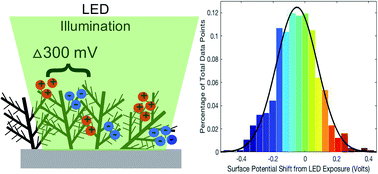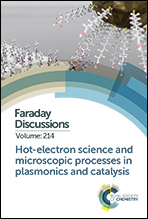The impact of optically rectified fields on plasmonic electrocatalysis
Abstract
Studies have shown that the excitation of plasmon resonances on nanostructured materials can drive catalytic processes. Plasmon resonances can be tuned across the solar spectrum, thus offering intriguing possibilities for their application in plasmonic catalysis. Previous work carried out by our group has indicated that nanostructures with tight junctions can create direct current (DC) electric fields. These fields arise from an optical rectification of the plasmon resonance on the plasmonic surface, and our group has shown that these fields modulate photocatalytic activity. This work looks to shed further light on the impact that optically rectified fields can have on catalytic reactions. Cyclic voltammetry shows that the electrochemical reduction and oxidation potentials of a 2 mM CuSO4 solution occur at ∼100 mV lower overpotential on an optically excited Ag nanodendrite electrode. Stark spectroscopy of the nitriles absorbed to these surfaces indicate photo-associated changes in the surface potential across the Ag nanodendrites. Localized areas evince photo-induced changes in the surface potential upwards of 300 mV. These results provide evidence of optically rectified fields altering the electrochemical reactivity on plasmonic surfaces and suggest that optimizing this nonlinear phenomenon may improve plasmonic photocatalysts.

- This article is part of the themed collection: Hot-electron science and microscopic processes in plasmonics and catalysis


 Please wait while we load your content...
Please wait while we load your content...